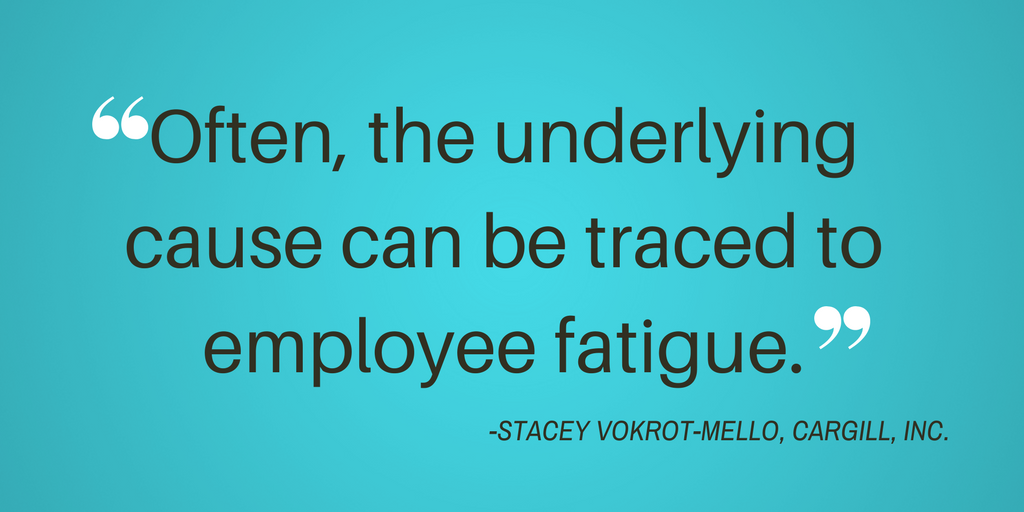I talked to Stacey Vokrot-Mello of Cargill Inc. about the challenges and benefits of driving sustainable process improvements through organizational alignment. Stacey will be presenting ‘Driving Sustainable Process Improvement Through Organizational Alignment’ at APQC’s Process & Performance Management Conference.
Stacey Vokrot-Mello currently serves as a Business Process Optimization Leader at Cargill within the Food Ingredient and Bio-Industrials platform.
 What’s the most common reason you find process improvements aren’t sustainable?
What’s the most common reason you find process improvements aren’t sustainable?
Improvements to processes are difficult to sustain when:
- Ownership of the process is not well defined.
- Employees responsible for executing the process are not properly equipped to perform their role.
- Value of the improved process has not been demonstrated to leadership.
As a process improvement champion I have experienced each one of these challenges but thankfully, they are obstacles that can be removed with appropriate planning within your project and a thoughtful approach to the future state you are trying to achieve.
People talk about creating a culture of continuous improvement, but what are characteristics of a successful process culture?
This is a good question and one with which I’ve recently wrestled! To really create a sustainable continuous improvement culture in an organization the approach should consider the unique needs across various stakeholder communities (i.e. employees, senior leaders, external parties). Success is achieved when the organization’s leadership has adopted a communications style and expectation of performance that conveys continuous improvement, employee levels of engagement have been elevated to enable ideas for improvement to be more readily forthcoming, and external stakeholders have an increased level of commitment to the business as they see themselves as beneficiaries of many of the improvement projects executed in the organization.
What is an early sign your process improvement plan is off track?
Improvement planning can fall off-track for a variety of reasons. Often the underlying cause can be traced to employee fatigue (too many “tried but failed” projects in the past), lack of alignment of the initiative to the strategic plan for the business, and an absence of key capabilities amongst employees (e.g., project management and continuous improvement tool set) that are necessary to drive execution and sustain results. Thankfully there are ways to address each of these that I’ll discuss during my session.
If employees grow weary of applying effort to a situation that is not improving are there ways to re-engage before all hope is lost?
I’m an eternal optimist so yes, especially if the effort is hindered only by employee weariness. Whether you are the project manager or the direct supervisor of employees working to improve a process, you need to remove the roadblocks that stand in the way of your team making progress. If they are fatigued you need to explore the source of that concern and work to address it. It could be that the skills required are not available on the team. Perhaps the objective is not well understood and competing priorities and misalignment are the cause of the frustration. Or perhaps there are stakeholders within the organization who are standing in the way of progress (I refer to this as the “Heisman” – the acknowledgement that while I appreciate your attempt to assist, I don’t need any help – I’ve “got it”). I’ve experienced all of these and more and can say that with some careful thought and planning, you can regain momentum and set your team on the path to success.
Even in organizations where there is a culture of process improvement, what are things organizations should do to maintain that culture?
Once the hard battle of creating a culture of continuous improvement has been won, you certainly want to maintain it. Things to consider include leadership language–what they say really matters. Leaders should routinely talk about improvement initiatives and the value they bring to the business. As a practitioner you should ensure that they have ample content to convey. Second, relevant skill building should be available and promoted alongside other development opportunities offered to employees. Keeping the saw sharp and employees engaged is key. Finally, connect and collaborate with various communities of practice (APQC is a great example!) to gain insights and explore new and innovative ways organizations are succeeding through ongoing process improvement!